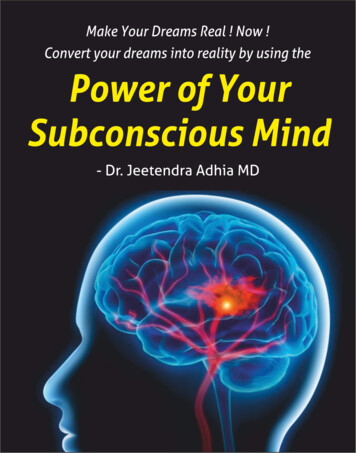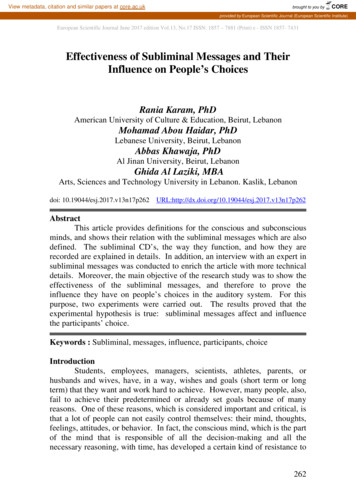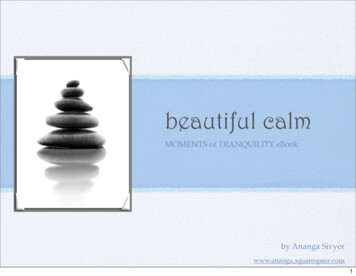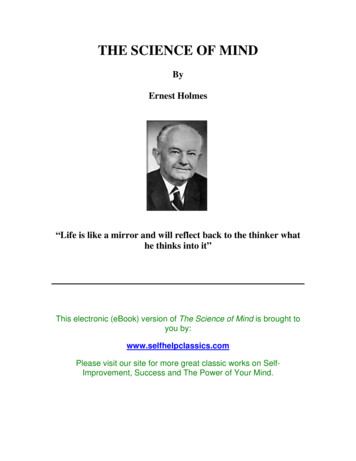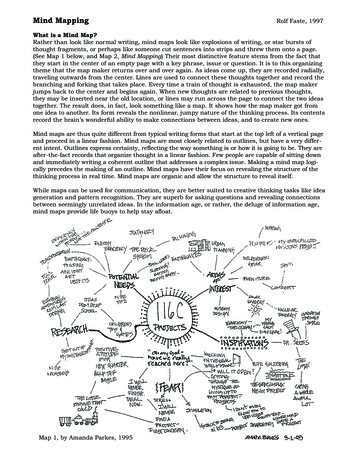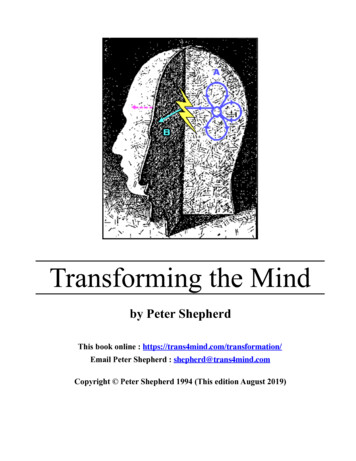
Transcription
Transforming the Mindby Peter ShepherdThis book online : https://trans4mind.com/transformation/Email Peter Shepherd : shepherd@trans4mind.comCopyright Peter Shepherd 1994 (This edition August 2019)
iiTransforming the MindContentsChapter One: INTRODUCTIONAn evolutionary jump.6What is Personal Development? . 7What is required of you? . 7Chapter Two: BACKGROUND PSYCHOLOGYThe evolution of man .9Transpersonal psychology . 10The Child Personality .18Parent - Adult - Child .20Sub-personalities . 21Man the machine? . 22Consensus trance . 23Defense mechanisms . 26Fear - attachment to time. 27Stress - the cost of fear .29Rational thinking . 29Combating distortions . 3116 types of distorted thinking .32Misconceptions.37Rational Emotive Therapy. 39Inferences .40Secondary emotional disturbance.40Irrational Beliefs .41Shame-attacking .42Self-esteem versus Self-acceptance .42Towards, against and away .45Imprint-types . 48The semantic mind .52
Transforming the MindContentsSexuality .55Chapter Three: ANALYSISCommunication in Therapy . 60Discharging Traumatic Incidents. 61Modes of Representation. 62Filtering . 63State-dependent memory . 64Recovering Memories . 65‘Recall Something’ .66Life-Chart .67Zen Memory Exercise . 67Habits to observe . 67Sexual Man .70To be free of negative memories . 71The Release Technique .72Release Technique - Procedure . 74Toxic Parents . 75Reframing .78It’s their responsibility. 79Taking personal responsibility. 79Toxic Relationships . 80Only a person who takes risks is FREE .86Chapter Four: REVERSAL THEORY & THE SPLIT BRAINTelic and Paratelic states . 87The use of biofeedback in analysis . 89Use of the meter .90Incremental changing of habit patterns . 92Two ways of knowing . 94Symbol Space .99Reality Testing. 100Reversal Theory .101COEX Systems .102Volition .106Pan-determinism.110Body-mind defenses . 112The structure of problems . 113iii
Transforming the MindContentsBeliefs.117Achieving Goals .118Words and Meanings . 120Semantic Development . 122The Higher Mind . 123The Three Worlds .125The Semantic Differential . 126Awareness Exercises . 133Creative Communication. 148Chapter Five: MOTIVATIONNeeds . 154The Unified Field .155Telic stress . 158Telic Dominance.159Creativity . 162Education. 163Sport .164Sex . 165Forms and colors . 165The COEX . 166Disturbances and trauma . 169The Stable Person .173Chapter Six: THE OPEN FOCUS STATEHigh arousal .176The gamut of emotions .178Transactions. 181Primary Beliefs .185The pride system . 189Unconsciousness . 191Attention .194The Holistic Program .197Dynamic Consciousness .200Chapter Seven: AWAKENING!The Father . 204Personal identity .214iv
Transforming the MindContentsTypes of culture . 214The archetypal enemy . 217Towards the Real Self.219Towards the Higher Self .224Awakening!.228Chapter Eight: DISCOVERING THE HIGHER SELFFinding the Inner Self .234A Paradigm Shift . 235Insight .236The Gnostic Way . 237The Age of Anxiety . 237Beyond Survival .239The Nature of ‘Spirit’ .242Bibliography .244Appendix: The BRAINUnlimited potential .244The functional structure of the brain . 248v
6Chapter One:INTRODUCTIONAn evolutionary jumpYou may, at some time, have had a ‘peak’ experience, an ecstatic moment or a momentof greater understanding, when your consciousness expanded - and you knew it. Whenthis occurs, the integration between left brain (logical thinking) and right brain(intuitive feelings and emotions) is manifested in increased energy-flow between thetwo sides. This is thinking and feeling in an holistic and balanced way. It is a foretasteof an evolutionary jump for humanity - and in essence, what the so-called New Age isall about - a new level of maturity in mental development, an awakening.By learning how to arouse the whole brain, selectively and at will, the mode ofconsciousness may be freely altered, appropriate to the task or situation - whether acrisis, making music, relaxing, mental arithmetic, brainstorming, or contemplatingnature.In this new wide-awake consciousness, the world seems to be full of possibilities - itpossesses a strong sense of rediscovered meaning. This is nothing mystical, it isessentially ordinary consciousness, operating for once at its proper efficiency.“When we pull back and get, for a moment, the ‘bird’s eye’ view of life, it revealsmeanings that are ungraspable by the narrow focusof our usual worm’s eye view”Colin WilsonResearch tells us that one side of the brain is usually dominant to the other, and thatmost of the time, very little of the potential capacity of the brain is in use. Brain studieshave shown that people who are functioning optimally have a high level of interhemispheric communication and that the two sides are working in synchrony andbalance, as described above. Also overall arousal is higher and under conscious control- this is the skill of sustained concentration.
Transforming the MindChapter One: Introduction7What is Personal Development?When you feel angry or depressed, in a self-defeating way, this is the result of negativeor irrational inner-speech that you may not even be aware of, as it is often very fleetingor below the threshold of consciousness, or simply not recognized as such.These evaluations are linked to earlier times, when they were instilled by force ofpainful experience. When such an experience was too uncomfortable to remember, thefeelings (in the right brain) were repressed and made unconscious.Considerable mental energy is locked-up by continuing to repress feelings andemotions, and this is justified by irrational and over-generalized conclusions about selfand others.The techniques presented in this book will enable you to look again at your beliefs witha fresh viewpoint. This will help you to release the effects of held-back trauma andhave fuller access to your potential for intuitive, creative and holistic thinking. With amore flexible outlook and greater freedom of emotional expression, new horizons mayappear, and goals approached that before seemed out of reach. Problems and difficultiesnow become opportunities for creative choice and valuable learning, stepping-stonestowards what you really want to achieve.When, as with most people, 90% of the brain’s capacity has been closed down due toneurotic repression, the remaining 10% is apt to fall into a robotic state. The individualacts out imprinted behavior patterns that are predictable from day to day and onlyresponds semi-consciously when something attracts his attention. The unused 90% issusceptible to hypnotic influences and the individual is driven by his environment andcircumstances; this is far from the self-determined state he probably considers himselfto be in. For most of us, a radical program of reawakening is urgently needed!We affirm that man’s nature is essentially spiritual but that it is no good seeking forspiritual things until we can distinguish the spiritual from the mundane. To attain thehigher mind of spiritual awareness and psychic ability we must be released from thethrall of the lower cognitive mind. This cannot occur with any stability (other than‘peak experiences’) until work on the lower mind is complete. While large areas of ourbrain lay unused because of their repressed content, there is a potential Achilles heel toany postulated state of satori.What is required of you?An open mind and a genuine desire to learn and expand. A major goal of personaldevelopment is to facilitate the development of self-determined people taking fullresponsibility in their lives. Indeed, we need to explore the unmapped territory of ourminds and develop it to the full, if we are each to have the insight to be able toeffectively cut through the blinkered thinking in our environments, and make an impact
Transforming the MindChapter One: Introduction8on what is happening to our world’s social, economic and ecological systems.Resolving the chaos of fixed ideas which nearly everyone has to some extent, is agradient process of analysis, of re-discovering objective reality and the honest truthabout ourselves.
Transforming the Mind9Chapter Two:BACKGROUND PSYCHOLOGYBefore beginning practical work on self-development, an overview of the humanpersonality will help to provide a context.The evolution of manPsychology, the study of the mind and how it works, is sometimes considered a newscience, but this is quite mistaken. It is possibly the oldest science and in its mostessential features even a forgotten science. Perhaps this misconception arises because,except in modern times, psychology was incorporated into philosophic or religioussystems.In India all forms of yoga are essentially psychology. Sufi teachings, which again arechiefly psychological, are regarded as partly religious and partly metaphysical. Almostevery religion developed psychological teachings, often connected with a certainpractice. In Europe, even in the last decades of the nineteenth century, many works onpsychology were referred to as philosophy.When modern psychology emerged as a discipline at the end of the nineteenth century,it was based on an analytic, biological view: interest was in the component partsparticularly in the biological ‘realities’ of brain, memory and so on, that could beempirically studied. When psychoanalysis was developed during the early part of thetwentieth century, as an application of psychology to treat mental conditions, itproduced the notion of ‘personality’, about the reality of someone’s individual andsubjective presence in the world. As the century has progressed, ‘personality’ as anotion has changed and modified with every new school.Each personality is that complex combination of drives, defenses, roles, learnedadaptations, potentials and consciousness, that lives in the world and is a unique being.In some quite remarkable way each person is unlike any other being that exists,qualitatively different, and yet is subject to universal laws, social and biological causes,and learned behavior that is common to all, and which makes for cultural patterns ofaction, describable and analyzable difficulties and illnesses, and similarities of behavioracross cultures that are discernibly ‘human’.Here it is necessary to note that all psychological systems and doctrines, those that existor existed openly and those that were hidden or disguised, can be divided into two chiefcategories:Firstly, systems which study man as they find him, or such as they suppose or imaginehim to be. Modern ‘scientific’ psychology belongs to this category.
Transforming the MindChapter Two: Background Psychology10Secondly, the systems which study man from the point of view of what he may become,i.e., his possible evolution. These last systems are in reality the original ones or in anycase the oldest and only they can explain the forgotten origin and meaning ofpsychology: the study of the principles, laws and facts of man’s possible evolution.The ‘evolution’ of man in this sense means the development of certain inner qualitiesand features which usually remain undeveloped, and cannot develop by themselves. Ifman does not want it, or does not want it strongly enough and does not make thenecessary efforts, and get the necessary help, he will never develop.The irony is, that before acquiring any new faculties that man does not now possess, hemust first acquire qualities that he thinks he already possesses but about which hedeceives himself.The following experiment will show how consciousness may be studied. Take a watchand look at the second hand, trying to be aware of yourself and concentrating on thethought, ‘I am (your name)’ and ‘I am now here’. Try not to think about anything else,simply follow the movement of the second hand and be aware of yourself, your name,your existence and the place where you are.Most people soon find themselves drifting into imagination and thought associations,demonstrating that man is not conscious of himself for most of the time. The illusion ofhis being conscious is created by memory. We actually remember only moments ofconsciousness, although we do not realize that this is so. In retrospect we rememberthose moments and assume we were fully awake the whole time.If we want to have more prolonged periods of awake consciousness and not merelyglimpses, we must understand that this will depend upon the command we have overourselves, and that this requires long and hard work.Man does not know himself. He does not know his own limitations and possibilities. Hedoes not even know to how great an extent he does not know himself. So he assumeshis mental state to be ‘conscious’, fully aware and self-determined, when in fact he isacting to a very great extent on automatic responses and continuously dramatizing allthe influences of his past.Transpersonal psychologyMost psychologies and psychotherapies are interested just in the personality. It is onlyin recent years that a variety known as ‘transpersonal psychology’ has emerged, whichcombines, or perhaps re-integrates, psychology and the personality, with theology andthe soul - two disciplines and two concepts that have been firmly separated in ourmaterialistic Western world, but which used to go hand in hand. For instance in earlyChristianity there was a collection of books by different authors under the general nameof Philokalia, describing the psychology of mystical enlightenment, and this knowledge
Transforming the MindChapter Two: Background Psychology11was the basis of Gnosis, itself the source of many of Gurdjieff’s ideas. (Freud himselfactually wrote about the psyche in terms of the ‘soul’, but his German was misguidedlytranslated into medical ‘scientific’ terms for the Anglo-American audience).In psychosynthesis, which Assagioli developed in the 1930s, it is said that a person hasa personality and is a soul. However, personalities in the world are obvious to us all;souls are only present for those with eyes to see. Assagioli's view of synthesis is ofbecoming more and more aware of soul, not only in oneself but also in others. Hisview, and the view of most spiritual disciplines, is that soul is basic and enduring, andthat personality, though necessary for being in the world , is relatively superficial andchangeable.The soul is the context, the home, the ‘unmoved mover’, the uncreated source of life;the personality is full of content, learned responses, and is dynamic. The soul may inmany people never be recognized in any explicit way, and the nature of this barrier andhow to remove it, to become ‘enlightened or to ‘awaken’, is an area we will beexamining later in this book.In the eighteenth and nineteenth centuries, before Freud, and with the values of theEnlightenment and the idea of progress, it was assumed that the human being wasbecoming more and more rational and fully civilized. It was this assumption that Freudquestioned, with his ability to discern the unconscious processes in people. He saw thesignificance of dreams as a communication of the unconscious to the conscious; slips ofthe tongue, mistakes, irrational emotion, inappropriate behavior and illnessesmanifested in ordinary living began to be acknowledged as effects of processes goingon beyond our consciousness. Many hitherto unexplained phenomena came to be seenas symptoms of the conflict between the strong ‘libido’ (sexual) forces of the ‘id’ (thedrive or life force of the core Self) and the ‘super-ego’ (the acquired conscience), asperceived by the ‘ego’ (that part of the id that detaches early in development to form anindependent personality - the ‘face to the world’).There are five main parts of our total psyche: Higher consciousness - that which isaware of being aware; Normal consciousness - awareness in the everyday world being, perceiving, relating; and of the inner world - of thoughts, concepts, attitudes,decisions, images, memories emotions, sensations and feelings. And the domains whichlie below normal consciousness: the Pre-conscious - an interface of the conscious mindwhich, when it is evoked by interest and emotional commitment, goes searching forrelevant data in the sub-conscious; the Sub-conscious - contains the powerful drives oflove and fear, and the programs by which motives are decided and actions are carriedout; and the Unconscious - the core Self which contains a record of everything one hasfelt and sensed since conception and of the evolutionary genetic-line before that. It alsoconsists of genetic programming, which empowers the deepest drives for survival,attachment and expression common to mankind, which transmits the energy ofemotions, which controls the stream of libido energies and the efforts involved inmoving and perceiving with the physical body.
Transforming the MindChapter Two: Background Psychology12Higher consciousness is the essential self, the Higher Self. It is our personal center ofawareness, which is developed through self-knowledge. The Higher Self is the‘awareness of awareness’ of which the mental (ego) ‘I’ is a pale reflection. There hasbeen an acknowledgement throughout human history that a higher awareness, beyondthe normal conscious experience, is possible for the individual, recognized throughdreams, religious and psychic experience, insights and creativity of every kind. It isusually frustratingly brief and infrequent but it is clear that with appropriate efforts andstudy, people can change and grow in awareness, whereby the field of consciousnessbecomes more and more observed by the Higher Self who is no longer asleep; thenbehavior is no longer determined only by conditioning. The Being is aware of thedifference between his own motivation and that which is learned, acquired or installedin him, genetically or by conditioning; he knows what he is doing as he does it. Theenergy and attention tied up in the knots of unconsciousness becomes conscious andfreely available, as truth is validated and the false discarded.This second aspect of the psyche, Normal consciousness, is our everyday reality,internally and externally - the incessant flow of sensations, images, thoughts, feelings,desires and impulses which we can observe, analyze and judge. The less aware aperson is, the smaller this field of awareness will be and the more automatic hisfunctioning. The majority of people drift on the surface of this ‘mind stream’ andidentify themselves with its successive waves, with the changing contents of theirconsciousness. So consciousness is often unreflective, not consciously noticed,determined by the many personal and social forces which have formed us, the culturalprogramming that moulds us into a ‘consensus trance’ of automatic, robotized behavior.In this hypnotized, half-asleep state, possessed by the conditioning of our background,we seem almost entirely the product of our genetic heritage, our personal environmentand the society we live in - in the grip of forces stronger than ourselves and which wedon’t understand, be they biological, psychological or social.The conscious mind contains all that one knows that is readily accessible. Thisinformation is well organized and interconnected on a logical basis. The characteristicsof this ‘analytical’ mind are invaluable for learning, putting things in order and testingideas. On the other hand the conscious mind tends to be inhibited by the very qualitythat make it so powerfully useful: it seeks to be right.This part of the personality, the subject of cognitive and behavioral psychology, couldeasily, without reflection, be regarded as the whole, but the development of depthpsychology and the rediscovery of transpersonal psychology in this century has made itclear that this level of consciousness is only a part of the whole.The third part, the Pre-conscious, is the ante-room of consciousness, where our variousexperiences are assimilated, our mental and imaginative activities are elaborated anddeveloped in a sort of psychological gestation and interaction, before their birth into thelight of consciousness. If consciousness is likened to a spotlight, the pre-conscious iseverything within its range, but not illuminated at this moment. It is real to the person
Transforming the MindChapter Two: Background Psychology13and accessible. It includes material from the sub-conscious that has been reactivated(stimulated and made active due to a similarity or relevance of present circumstances orthoughts). The pre-conscious mind is like a problem-oriented and independent fileclerk. It looks over the shoulder of the conscious mind: when a problem is beingconsidered, it conducts a search into the sub-conscious mind for clues that it considersrelevant.Its criteria for relevance do not always seem logical to the conscious mind, andtherefore the ‘file-clerk’ learns to censor certain kinds of information from the subconscious, preventing them from rising higher into full consciousness. This ‘censor’ isbelow consciousness; consequently you cannot open-up your mind to the sub-conscioussimply by resolving not to block its signals; the defenses have first to be recognized, thereasons for them discovered and the pre-conscious censor re-programmed, before this ispossible. This requires a procedure
Transforming the Mind 9 Chapter Two: BACKGROUND PSYCHOLOGY Before beginning practical work on self-development, an overview of the human personality will help to provide a context. The evolution of man Psychology, the study of the mind and how it works, is sometimes considered a new science, but this is quite mistaken.Author: Peter Shepherd



